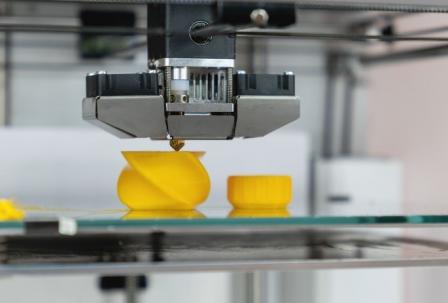EPA Researchers Continue to Study the Emissions of 3D Printers
Published June 15, 2021

In less than 50 years, 3D printing went from fantastical science fiction to a common fixture for home hobbyists. Low-cost 3D printers are increasingly being used in residential, small business, and educational environments to create unique, physical 3D objects from digital models. This rapid growth in the market has led EPA researchers to study the effects of emissions from these printers on human health.
Studies have found that the 3D printing process releases gases and particulates which could pose health risks to users. These emissions include volatile organic compounds, referred to as VOCs, some of which are hazardous to human health when inhaled. The particles released are of ultrafine size (1–100 nm), and researchers have found that they are small enough to be deposited deeper into the respiratory system and can be more difficult to clear from the body.
What materials produce these emissions?
Common 3D printer ‘ink’, called filament, is a thermoplastic that is partially melted during the printing process to form the desired 3D object one layer at a time. There are different types of filament material available to choose from, with the most popular material choices being poly-lactic acid (PLA) and acrylonitrile butadiene styrene (ABS). PLA filament is derived from renewable sources like corn and is advertised for its abilities to reduce greenhouse gases during use and to biodegrade. ABS is derived from processing petroleum and is often used in industry because of its chemical resistance.
EPA researchers examined different characteristics of PLA and ABS filament emissions by collecting data from 16 different 3D printer emissions studies. They found that the majority of particles released when using both of these materials were of ultrafine size, indicating that using both ABS and PLA may present a potential for exposure to respirable particles. They also found that using ABS filament resulted in greater particle numbers than PLA filament, suggesting that users of ABS may be exposed to an increased volume of ultrafine particles.
Instead of using pre-made filament, users will sometimes instead use filament ‘extruders’, which create feedstock for 3D printers from raw plastic pellets. EPA researchers found that ultrafine particle number emission rates from extruders were comparable to those found in other 3D printer studies, concluding that filament extruders may present additional risk to users.
Children’s exposure to 3D printing emissions
The availability of published studies evaluating the effects of 3D printer emissions on respiratory health is limited, and all have focused solely on adults. However, 3D printing has become a popular educational tool, meaning children and teenagers could be regularly exposed to 3D printer emissions. This may be of concern because the effects of these emissions could disproportionately harm children compared to adults. Children may be exposed to high concentrations of 3D printer ultrafine particles due to uncontrolled use in confined spaces, like classrooms and libraries.
EPA researchers predicted the amount of particles that may be deposited from 3D printer emissions in different regions of the respiratory tract for children of various age groups from three months to eighteen years old using the open-access multiple path particle dosimetry model (MPPD v3.04). From this modeling, the researchers found that the greatest predicted mass deposition was highest in the range of nine to eighteen-year-olds, and that the greatest mass deposition was predicted to occur in the lungs.
Moving forward and protecting health
The National Institute for Occupational Safety and Health recommends that 3D printer users protect themselves by using materials with lower emissions, using enclosures for 3D printers and ventilation to capture chemical emissions, and reducing time spent near the printer while it is running.
Understanding the characteristics and human health effects of these 3D printer emissions is of great importance to EPA researchers, especially as the market for these printers grows. EPA researchers plan to continue their studies in hopes of limiting exposure concerns to 3D printer users.
For more information on EPA’s 3D printing research, see “Keeping up with 3D Printing: EPA Researchers Build on New Plastic Emissions Study”. For more information emerging materials research at EPA, check out the EPA nanomaterials research page here.
